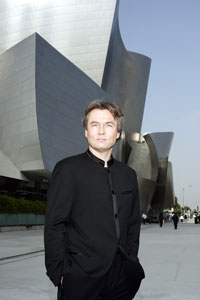by: Bill Millard
Event: NYPL Live: Frank Gehry and Esa-Pekka Salonen in conversation with Barbara Isenberg and Alex Ross
Location: New York Public Library, 05.11.09
Speakers: Frank O. Gehry, FAIA — Principal, Gehry Partners; Barbara Isenberg — Associate Director, Los Angeles Institute for the Humanities, & Author, Conversations with Frank Gehry (Random House, 2009); Alex Ross — Music Critic, The New Yorker; Paul Holdengräber — Director of Public Programs, Research Libraries of the New York Public Library (substituting for Salonen, composer and former conductor, Los Angeles Philharmonic)
Organizers: New York Public Library
Listeners anticipated a breathtaking game of brain tennis between Frank Gehry, FAIA, designer of LA’s Walt Disney Concert Hall, and Esa-Pekka Salonen, the innovative conductor who has made it the home base for his orchestra’s experiments. Due to a back injury forcing a last-minute cancellation by Salonen, the speakers, instead, improvised on a range of topics — the importance of play in composition, the emigrant community in Los Angeles, the phenomenal tone achieved in Disney Hall by acoustician Yasuhisa Toyota, the limits of “faceless” museum design despite many artists’ preference for it, and the oddity of the inquiries Gehry has received from neuroscientists about the nature of inspiration, including whether it’s more likely to occur in round or square rooms.
Music has long commanded and focused Gehry’s attention, and his remarks took on particular animation during interchanges with music writer Alex Ross about Salonen’s mission to strengthen audiences’ understanding of 20th-century modernist music, particularly its continuities with earlier tonal forms. (The precision and logic of Bach’s Goldberg Variations appeals strongly to Gehry.) Paul Holdengräber, director of public programs at the NY Public Library’s research libraries, elicited several remarks on process: though his firm’s use of digital design technology has revolutionized the field, Gehry favors hand sketching and fears that computers are eroding that skill among younger architects. He explained his tendency to revise sketches extensively, or nearly indefinitely, to incorporate evolving program, site, and budget information into an initial idea (“It’s like a crystal; I keep it liquid as long as I can”). He also addressed the local-interest question raised by several audience members, the status of his contribution to the stalled Atlantic Yards complex in Brooklyn — he maintains a glass-half-full position.
Gehry differs from several of his Pritzker-laureate peers in being reluctant to offer general theories. His public statements reveal a lively intellect, and he is relaxed enough to play along with self-effacing anecdotes such as his cartoon-mediated appearance on The Simpsons, turning a discarded sheet of crumpled paper into a concert-hall design for Springfield and pronouncing himself a genius. Ross played an excerpt from Salonen’s Wing on Wing, a site-specific composition that references the sail and fish shapes that inspired Disney Hall and includes samples of Gehry’s voice (including the phrase “Why the fish?” — to which orchestra members invariably reply in rehearsal, “Because there’s no beef”). About Gehry’s imagination, there’s nothing fishy at all, and there’s plenty of beef.
Bill Millard is a freelance writer and editor whose work has appeared in OCULUS, Icon, Content, The Architect’s Newspaper, and other publications.










